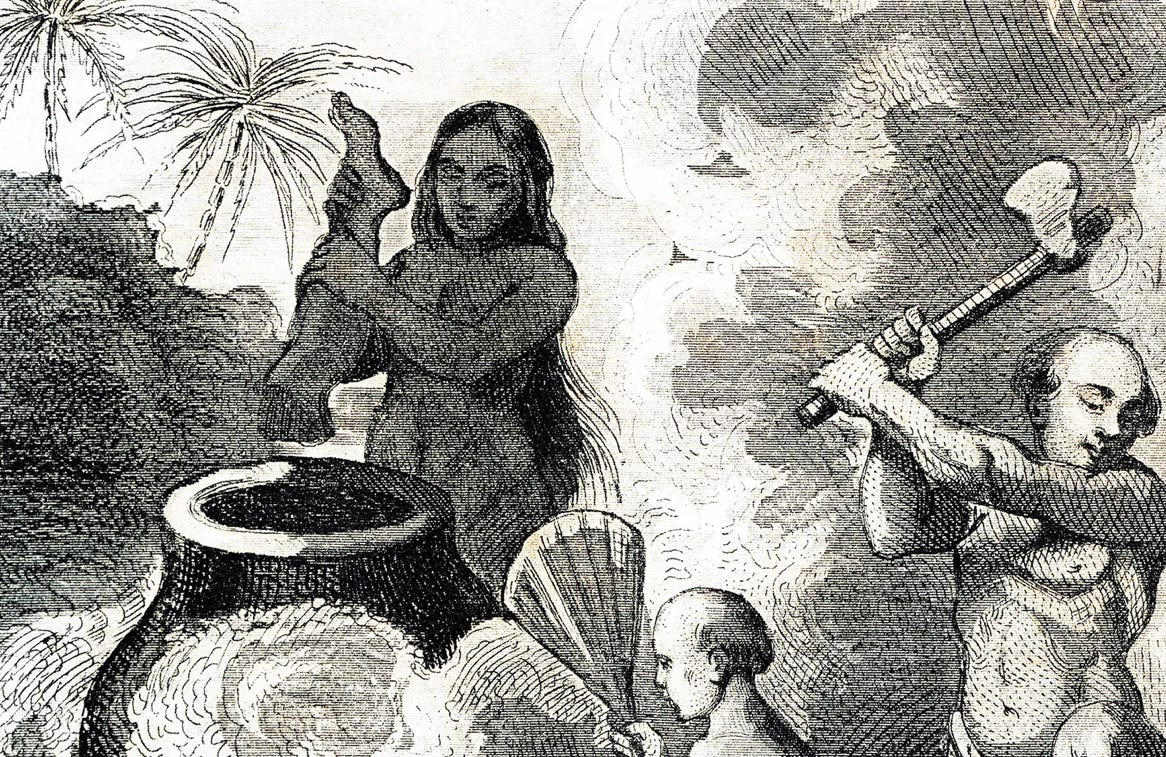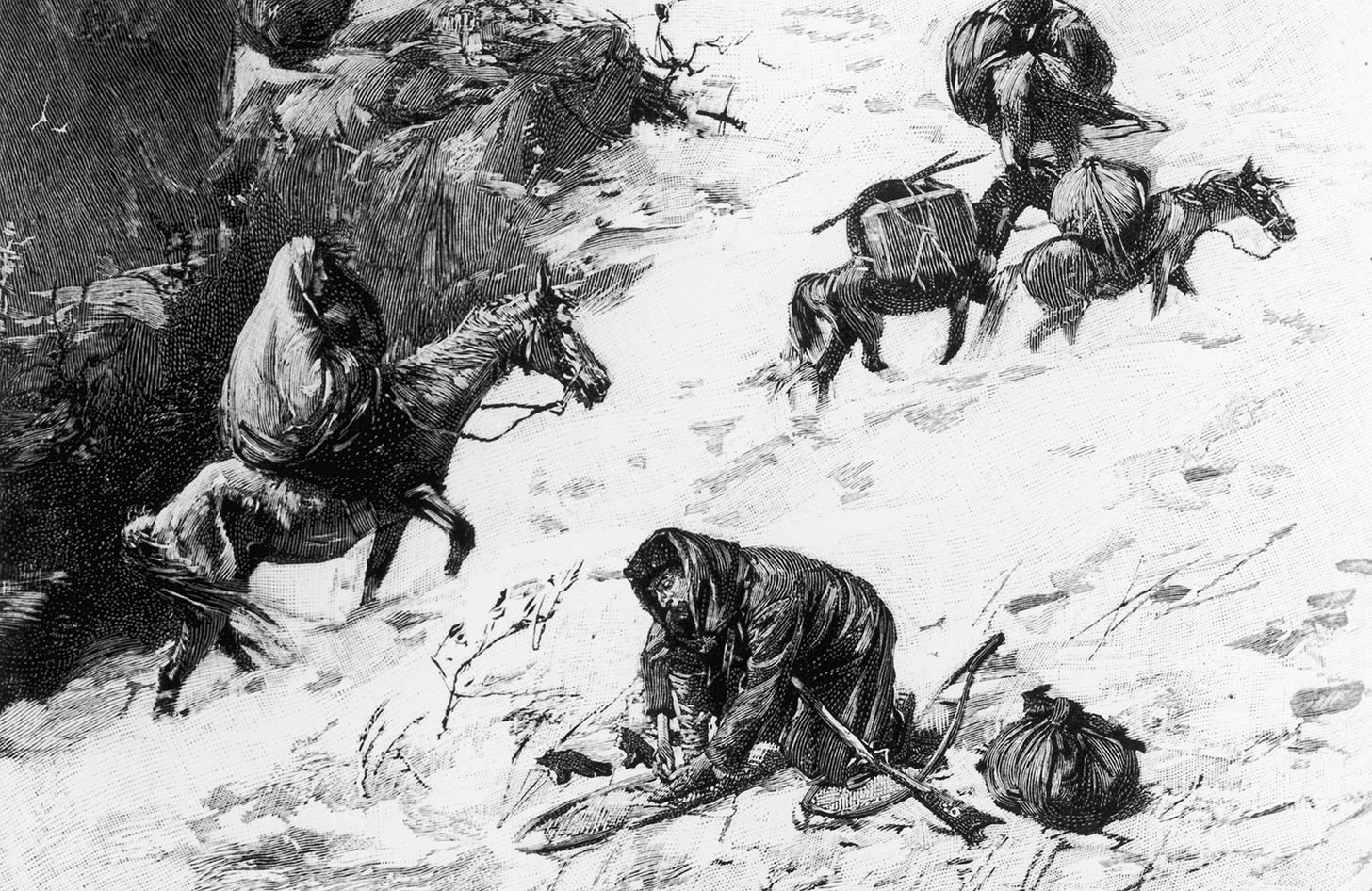21st Century Cannibalism
Part 1: WARNING: Extremely Disturbing Video as a Man Eats a Human's Body While Onlookers Watch. Part 2: Facts on Cannibalism. Part 3: A List of Foods and Other Products Containing Human Fetal Tissue.
Image Courtesy: Swisscows.com
My heart breaks in bringing this to you, but let us remain strong in the Lord together.
🤮 👿 WARNING: You cannot unsee this purely evil video without wanting to vomit. I will walk you through it and then you can decide whether or not you want to watch it. My intention is to expose the darkness and shine light on the evil, as God intends us to do.
I will tell you what's next on the article, so you know before scrolling down.
Then if you hear about this, you will know that it's true, because you will have seen it with your own eyes.
Video Description
I found this video in one of my many Telegram groups. There was no explanation of where this was taken, nor the language, context, timing, or any other details.
The Scene: A bustling street. Motorcycles, a crowd of people.
A Black man is standing next to a burning a human body in the middle of an outdoor walkway, surrounded by a huge pile of junk and debris in the street, crumbled buildings in the background. About thirty onlookers watch him and a large fire emanating from the dead body. The body is charred black, and the legs are facing us.
Honestly, my brain did not want to see a human being being burned and then eaten.
I initially thought that it was a lamb or some other creature. But then you can clearly see a leg and a human foot; there is no mistaking that this is a person.
It cannot be his first time, because he chews it as if he likes it. He disgustingly licks his fingers as he eats it, at one point smacking his lips and licking the entire palm of his hand, almost as if to show off. It is nothing short of Satanic evil.
Perhaps the man's voice we hear is the photographer, who eggs him on, escalating his voice almost as if to cheer him on to go ahead and take a second bite. People near the camera cheer him on.
The man leans over to the body and picks up a piece of it. He chews it with pieces falling out of his mouth, as most in the the horrified audience silently stands watching.
A couple of people walk by the camera, and one stops to videotape him as he keeps chewing. At this point, the camera does a closeup as he continues to chew, pieces falling out of his mouth. At one point, a piece falls on the ground and he picks it up and eats it.
Then he goes back to the body and (I am sorry to describe it) he pulls off a piece of muscle from the back of the person's right knee, behind the leg. He puts it in his mouth and again chews it with pieces falling out of his mouth. He appears to then manage a piece of fat (?) that he takes out of his mouth.
THIS IS A PICTURE NEAR THE OPENING OF THE VIDEO
You can see the crowd, debris everywhere, and the cannibal leaning over to pull meat off the dead, burning body:
That may be all you need to see.
At the end, the cannibal simply walks away as the same man's voice eggs him on with a lady's voice that adds a high pitch to the fervor.
The Video
If you just listen to the audio, you can hear the cameraman (?) say the French word, “Monsieur”, which means, “Mister”. It seems like they otherwise didn't know each another by name.
This is the video, below. If you are sensitive or an empath, you may want to refrain from viewing it.
I don't know what country this was filmed in, but for the record, French is one of the official languages of Haiti, but a small portion of the population speaks it. Estimates are that 90-95-% of the Haitian population speaks Haitian Creole, which is a French-based language that originated in the late 17th and early 18th centuries. Perhaps this is Haitian Creole.
Thank you for bearing through this with me. Never in my life did I ever believe that my eyes would see something like this.
The only thing that I can do is to separate myself as far away as possible from this evil, and to pray.
Facts on Cannibalism
Cannibalism can show up at the most unexpected points in history.
Most people don’t associate cannibalism with the Soviet Union. But as Timothy Snyder describes in his book Bloodlands, the 1933 Stalin-imposed famine in Ukraine was so severe that cannibalism became surprisingly prevalent. The state had to set up an anti-cannibalism squad, and hundreds of people were accused of eating their neighbors or, in some cases, their family members. (Ron Rosenbaum shares many of the gruesome details in a book review for Slate.)
The grisly episode makes vivid the deprivations of the early Soviet era. That many Americans may have never heard of it illustrates another fact about cannibalism — it’s something no one ever wants to think about. It’s relegated to disgust, tabloid voyeurism, and lame jokes, and those all contribute to a general ignorance of the subject.
Historians and anthropologists, however, have tried to study the history and science of cannibalism over the years: why it happens, when it occurs, and who’s affected. It tests the ultimate boundaries of cultural relativism, health, and ritual. Though this list isn’t at all comprehensive, it catalogs some of the unusual things about cannibalism you might have missed.
Turns out there are a lot of myths about cannibalism — and how it’s been practiced over time. Here are a few surprising things experts have learned:
1) Humans are mostly hard-wired against cannibalism — but not always
There’s a good biological reason why cannibalism is taboo in virtually every culture: Eating other humans can make you sick.
Specifically, eating the brain of another human being can cause kuru — a brain disease that’s similar to mad cow disease. Kuru occurs because our brains contain prions that transmit the disease. Symptoms begin with trembling and end in death.
Not all of them fell victim to the disease...
What’s surprising, though, is that this isn’t always the case. Among anthropologists, the Fore people in Papua New Guinea are known for cannibalism. Up until the late 1950s, they ate the bodies of relatives to cleanse their spirits. Thousands of Fore contracted kuru and died (“kuru” actually comes from the Fore word for shaking). But not all of them fell victim to the disease: Over the last 200 years, some Fore have also developed a genetic mutation that protects them from the prions that transmit kuru.
The Fore were adapting to cannibalism — with natural selection possibly playing a role in reducing their susceptibility to disease. Scientists have been trying to study this further, but in recent decades, cannibalism has been declining among the Fore because of changing social mores and laws. If that continues, kuru may be wiped out entirely.
2) Animals are mostly hard-wired against cannibalism — but not always
Cannibalism is rare in the animal kingdom — except when it isn’t.
A few years ago, Natalie Angier of the New York Times chronicled the tales of the cane toad, caecilian, redback spider, and other animals that eat their own species. The cane toad, for instance, actually prefers cane toad eggs to other options.
How can that possibly be a good idea? Here’s Angier: “Researchers propose three motives. The practice speeds up maturation; it eliminates future rivals who, given a mother toad’s reproductive cycle, are almost certainly unrelated to you; and it means exploiting an abundant resource that others find toxic but to which you are immune.”
Those evolutionary imperatives extend to a wide range of organisms — even including occasional cannibalistic dalliances from animals like the sloth bear. As Mary Bates described in Wired, it’s not unknown for sloth bears to eat members of their own family (possibly because they’re under stress).
These human and animal cases are more than curious footnotes. They show that evolution can work in ways that run counter to our cultural values. Evolution happens through natural selection and doesn’t always line up with things we might value as a society, and evolved cannibalistic behavior illustrates that important distinction.
3) “Cannibalism” was named after people who might not have been cannibals
Caribs depicted as cannibals. (MPI/Stringer/Getty Images)
A few basic questions about cannibalism are difficult for historians to answer: How many groups practiced cannibalism? When did it start? And how common is it? Those questions are tough because “cannibalism” has been used throughout time to describe many different things. That’s also the reason most modern anthropologists and scientists prefer the term “anthropophagy” to “cannibalism.”
There are cultures that engaged in cannibalism as a ritualistic practice, but there are also times when people resorted to cannibalism during famine. And at times, the word “cannibalism” has been used to describe all sorts of tactics — and people — seen as savage. Cannibalism is occasionally descriptive, occasionally circumstantial, and occasionally an indirect ethnic slur.
Case in point: The word “cannibalism” itself comes from the name that the Spanish gave to the Caribs (Caníbales). The Spanish accused the Caribbean tribe of ritualistically eating their enemies, but modern-day scholars have doubts that it actually happened. Because the Caribs were engaged in an anti-colonial battle with a host of European powers, many historians now argue that the cannibalism rumors were just a propaganda tactic by the Spanish meant to stir up fears.
On the other hand, we have some evidence the Caribs used body parts as trophies, so cannibalism is a possibility — especially as an intimidation measure or act of war. However, most of our initial testimony comes from Columbus, who had many reasons, both personal and political, to make the Caribs seem as savage as possible.
4) Cannibalistic rituals could be surprisingly complex
An engraving depicting the Tupi. (DeAgostini/Getty Images)
One of the first prominent European accounts of cannibals appeared in Montaigne’s late-1500s essay Of Cannibals. In addition to being an invaluable anthropological record of the Tupi people in what is now Brazil, the essay sheds light on the intricate practice of cannibalism at the time. Sometimes, the Tupi lived with their captives for months before they were eaten. And they sang to each other.
As Montaigne recorded, the captors taunted captives by “entertain[ing] them with threats of their coming death.” And the captives replied in a fashion that was like a song or chant. Montaigne writes:
I have a song composed by a prisoner which contains this challenge, that they should all come boldly and gather to dine off him, for they will be eating at the same time their own fathers and grandfathers, who have served to feed and nourish his body. “These muscles,” he says, “this flesh and these veins are your own, poor fools that you are.”
Musicologist Gary Tomlinson, who wrote about the Tupi in The Singing of the New World, describes it as an “economy of flesh” that passed through the warring tribes for generations.
“It was a transaction across generations in these warring societies,” Tomlinson says. “They were saying, ‘In the future, you will be captured by my people, and we will eat you.’ The transaction goes on and on.”
5) Cannibalism was practiced in Colonial America
Archaeologists with a reconstruction of the Jamestown cannibalism victim. (The Washington Post/Getty Images)
Many people might think of cannibalism in distant history and undeveloped countries. But cannibalism was a feature of early American history too.
In 2013, archaeologists revealed they’d found evidence of cannibalism in Colonial Jamestown — an indication of just how desperate early Colonial life had been. Specifically, they discovered markings on the skull of a 14-year-old girl that strongly indicated she’d been eaten by settlers during the particularly difficult winter of 1609.
It was more concrete evidence for something historians had read stories about for years. As Howard Zinn excerpted in A People’s History of the United States, one government report painted a grim picture of that winter:
Driven thru insufferable hunger to eat those things which nature most abhorred, the flesh and excrements of man as well of our own nation as of an Indian.
6) The Donner Party wasn’t solely about cannibalism
An illustration depicting the desperate journey of the Donner Party. (Fotosearch/Stringer/Getty Images)
When most people think of cannibalism in America, they probably think of the Donner Party — the famous travelers who resorted to the practice when they were stuck in the snowy Sierra Nevada mountains while traveling west in 1846.
What’s surprising, however, is contemporary accounts of the trip focused less on the lurid accounts of cannibalism and more on the breadth of hardship that the party endured. As Donner Party historian Kristin Johnson notes: “Out of the more than 300 newspaper articles about the Donner Party published in 1847, the most common headline is a variation of ‘From California’ ... a mere seven [headlines] contain the word ‘cannibalism.’” Accounts tended to highlight the fact that the party only resorted to cannibalism after eating boiled animal bones, hides, and even a beloved dog, Uno.
What’s more, many people were just as interested in legends about the Donner Party’s buried treasure as they were in the cannibalism. In the 1890s, a Sacramento newspaper reportedthat treasure rumors made the people of Truckee, California, “feverish with excitement” and included discoveries that would “delight the heart of a numismatist.”
The treasure was probably a myth, but it shows that the story was considered far more complicated — and less purely shocking — than it is today.
7) Cannibalism was sometimes used as a medical treatment
There are many horrifying examples of cannibalism in Europe throughout history. But one of the most bizarre is that cannibalism was occasionally seen as a remedy. To pick one example, in Germany from the 1600s to 1800s, executioners often had a bizarre side job that supplemented their income: selling leftover body parts as medicine.
Apothecaries regularly stocked fat, flesh, and bone
As described in Kathy Stuart’s Defiled Trades and Social Outcasts, human fat was sold as a remedy for broken bones, sprains, and arthritis. Usually, this human fat was rubbed as a balm, not eaten. However, apothecaries regularly stocked fat, flesh, and bone, and there are also examples of a human skull being ground into a fine powder and mixed with liquid to treat epilepsy.
That treatment may sound strange, but remember that eating placenta has become a modern-day health fad. Most of the time, the popular verdict on cannibalism is clear — don’t do it. But occasionally, what’s cannibalism and what isn’t has been surprisingly hard to define.
Source: https://www.vox.com/2015/2/17/8052239/cannibalism-surprising-facts
Say No to Cannibalism
As a reminder, many of our popular foods are said to be tainted with human fetal cells. Many feel it imperative to stop eating these foods.
💥BQQQQQQQM💥
Boycotting Cannibalism: Foods Containing Dead Fetal Cells
Every time we eat any of the food sources listed below (and any time we eat the flesh and blood of another sentient being), we are participating in a satanic ritual. It’s time to say ‘no’ by never purchasing products made with dead babies again.
The following products are manufactured using aborted fetal cells:
PEPSI BEVERAGES:
– All Pepsi soft drinks
– Sierra Mist soft drinks
– Mountain Dew soft drinks
– Mug root beer and other soft drinks
– No Fear beverages
– Ocean Spray beverages
– Seattle’s Best Coffee
– Tazo beverages
– AMP Energy beverages
– Aquafina water
– Aquafina flavored beverages
– DoubleShot energy beverages
– Frappuccino beverages
– Lipton tea and other beverages
– Propel beverages
– SoBe beverages
– Gatorade beverages
– Fiesta Miranda beverages
– Tropicana juices and beverages
NESTLE PRODUCTS:
– All coffee creamers
– Maggi Brand instant soups, bouillon cubes, ketchups, sauces, seasoning, instant noodles
KRAFT – CADBURY ADAMS PRODUCTS:
– Black Jack chewing gum
– Bubbaloo bubble gum
– Bubblicious bubble gum
– Chiclets
– Clorets
– Dentyne
– Freshen Up Gum
– Sour Cherry Gum (Limited)
– Sour Apple Gum (Limited)
– Stride
– Trident
CADBURY ADAMS CANDIES:
– Sour Cherry Blasters
– Fruit Mania
– Bassett’s Liquorice All sorts
– Maynards Wine Gum
– Swedish Fish
– Swedish Berries
– Juicy Squirts
– Original Gummies
– Fuzzy Peach
– Sour Chillers
– Sour Patch Kids
– Mini Fruit Gums
– Certs breath mints
– Halls Cough Drops
NEOCUTIS “BEAUTY” PRODUCTS:
Neocutis uses aborted male baby cells after a 14 week gestation period in their anti-wrinkle creams. The following creams they sell contain aborted fetal cells, but we need to boycott all their products.
-Bio-Gel Prevedem Journee
-Bio-Serum Lumiere
-Bio Restorative Skin Cream
VACCINES:
-MMR II (Merck)
-ProQuad (MMR + Chickenpox — Merck)
-Varivax (Chickenpox — Merck)
-Pentacel (Polio + DTaP + HiB — Sanofi Pasteur)
-Vaqta (Hepatitis-A — Merck)
-Havrix (Hepatitis-A — Glaxo SmithKline)
-Twinrix (Hepatitis-A and B combo — Glaxo)
-Zostavax (Shingles — Merck)
-Imovax (Rabies — Sanofi Pasteur)
OTHER MEDICINES:
-Pulmozyme (Cystic Fibrosis — Genetech)
-Enbrel (Rheumatoid Arthritis — Amgen)
Source: https://t.me/sharirayepatriots/130639
P.S. If you have an idea what country the above video might have originated, or what language it is, please comment or message me.
For my previous article on cat blood and Haitian Vodou, see here:
LET US PRAY
Lord God, Almighty Father of Heaven and Earth,
We cry out to You for forgiveness! We repent of all our sins against You, and magnify Your Name on High!
We curse the sin of blood sacrifice and eating human flesh! We denounce it as Satanic, and will have no part in it! We are repulsed by the blatant disregard for human life and dignity, the abomination of indecent humans that act like animals, and the flagrant violation against Your creation.
Lord, we pray for these degenerate, misguided, evil humans who have crossed over to the darkness. Show them Your light. Let them see Your love. And as they continue to commit mortal sin, let them have their punishment that only You can provide.
Let us be brighter lights than ever before. Allow our boldness to cast out all the darkness and may it forever separate us from them.
We ask you to work within our hearts, so that we may become bolder and stronger in You. Lead us! Guide us!
In Jesus’ Mighty Name.
Amen. 🙏














The only comment that I want to write is that 'it's horrific.' Europeans gave up the practice, if there ever was a practice of filling your belly with a deceased relative or even your enemy in Europe. perhaps its coming back again now with the influx of the 3rd world.
Some cultures have destroyed whatever land they had and never developed agriculture and farming. What is happening in South Africa where the black natives are murdering white farmers and the people are starving may be a good example of what happens when a tribal people are eventually mind controlled by a foreign and vicious cabal that tells them to hate the white farmers or anyone else growing food.
Demonic